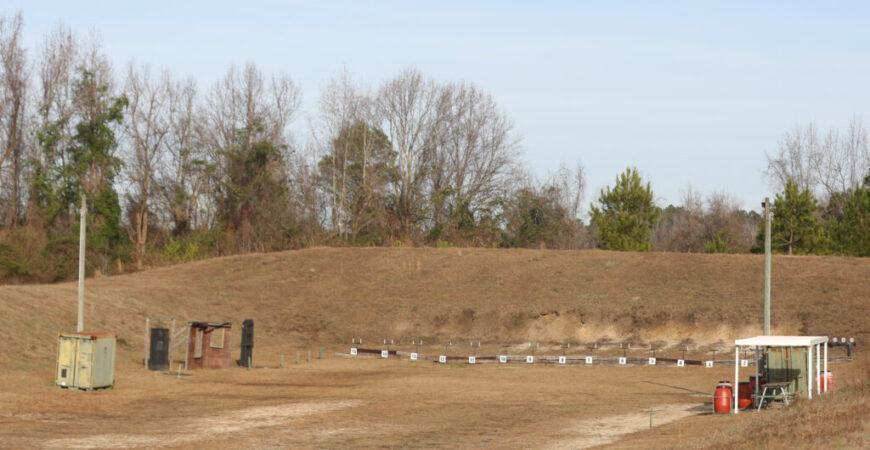Editor’s note: This is part two of a two-part series. Part one published on Dec. 20, 2023.
ROSE HILL –Located just a few miles from the county seat is the Sheriff’s Office Training Center. As Ben Parrish would say, “this is where all the magic happens.”
Each time a new officer is hired, the training center is their first stop.
“We have roughly 75 officers within the agency, at one point or another I’ve had all of them out here,” said Parrish.
The training facility is a true example of the kind of support that exists in the community and the collaborative efforts between government and businesses who year after year, champion for the people in Duplin County.
According to Parrish, in 2014, when he became the training coordinator, the property that serves now as the training center was being used as a clay pit for compost for the landfill.
“We approached Smithfield Foods Engineering Department,” said Parrish, explaining they asked for any help the company would be willing to provide for the construction of the range.
“Six weeks later, the ranges were finished, the berms and everything. That was their give back to the community,” said Parrish explaining that at the very beginning they had not even thought about a classroom, but as things progressed they were able to get a great deal for the construction of a shell building and the concrete. “We were able to utilize our county maintenance department to come in and cut all the panels. Inmate labor hung it. We used inmate labor to finish it up, they painted it and everything and we saved the county about $900,000,” said Parrish. “All total once it was completed with air conditioning, water, power, the whole nine yards, we got it for roughly $80,000 for the whole facility, so we are very, very proud of it.”
Agencies like the U.S. Marshals, NCIS react team, retired FBI LEOSA, Highway Patrol, SBI, DMV are just a few of the agencies that have conducted training at the facility.
“We’ve had Marine Special Operations Command out here doing their Raven exercise, which is their final training exercise before they deploy to a theater of operation. We have had the 3rd Special Forces Training Division from their transportation section come out and conduct training for us. We had the Robin Sage program from the U.S. Army Special Forces training section… You name it,” Parrish explained, adding that they don’t charge law enforcement or military agencies for access to the facility.
For Parrish, training has always been a passion.
“I wouldn’t change anything about my career,” said Parrish.
The training facility has two ranges which can accommodate up to 25 shooters going at one time. The ranges use a pipe system so when the rain comes off the berm it ends up down in an 8-inch tile in front of the targets. “It’s a closed tile, so we’re not allowing any lead to get into the water system,” said Parrish.
“We try to be very, very studious with the environment around us, making sure that it has kept clean. We’ve had a company come out of Florida to test the berm for lead and they said we’re good for about 25 years.”
The training center sits on an 11-acre property. Here they store military equipment acquired through the Law Enforcement Support Services Office (LESSO).
“We got these Humvees through the LESSO program for free… We got boats… we have generators, tents. You name it,” said Parrish as he explained how the diverse types of equipment enables them to conduct scenario-based training, aiding them in providing better services for Duplin residents.
They have four boats each capable of transporting 10 individuals. “We are in a team of swiftwater trained officers that are trained to go out and rescue individuals in a high-water situation.”
They also have ATVs obtained through the LESSO program, which enable them to do ground search and rescue. “We’ve tried to think of every eventuality and incorporate it into the services that we’re able to provide.”
Parrish added that they do all their maintenance inhouse except for electrical, and “it is all facilitated through donation or transfer or agencies like the U.S. Marshals purchasing our backers for the range targets.
“They purchase 50 targets or backers every two years. We can get anywhere from 35,000 to 40,000 rounds of use out of each backer, so it saves not only in cost, but it also saves the environment because we are not using cardboard, we can sit there and use these foam backers until they disintegrate and then they can be repurposed,” said Parrish.
“We’ve acquired $6.2 million worth of equipment — all free. The Humvees when they have outlived their life cycle with us, we turn them in, and we get another one or whatever the latest model is replacing that. The only caveat to it is we have to go and pick it up wherever it is located in the system,” said Parrish.
“We’ve picked up a couple of our Humvees from Fort Jackson in South Carolina, we have got some generators that we picked up from Eglin Air Force Base in Florida. The Conex’s we have gotten at Camp Lejeune.”
“We try and prepare for any eventuality that comes up,” said Parrish, explaining they train with the EMS department on active shooter scenarios. “We’ve incorporated them into our training so that we know what they need to do during a certain situation. The last call out that we had was on Blue Newkirk Road (about two months ago) and it was a nine-and-a-half-hour standoff with a barricaded individual… We hope and pray that every incident like that ends peacefully… We were able to get the individual out safely and get him the help that he needs.”
Parrish shared that mental health has been a huge problem, especially when dealing with involuntary commitments.
“That affects our agency because if we have to sit there and transport an individual to Ahoskie, or the western part of the state near Winston, Salem that takes that deputy out of the community where he’s assigned to protect and that may delay a response to somebody’s house that’s being broken into, or somebody being assaulted or something like that,” said Parrish.
The combat veteran explained that is one of the biggest reasons for needing more officers and trying to prevent turnover. This year alone he had about six officers that came through the training and left for varied reasons, a couple went to work for the Highway Patrol. “It definitely impacts us… training and equipping that officer is an expensive cost to the agency and then if that officer doesn’t stay but six to eight months and then moves to another agency, we basically trained somebody else’s officer,” said Parrish.
According to the Sheriff’s Office, it costs between $15,000 to $20,000 from the time an officer turns in an application, goes through the background investigation, polygraph, psychological background, and the 12-week program with their field training officer, plus an additional $2,000-$4,000 for equipment and uniforms.
“This year alone this office responded to over 22,000 calls for service, and that’s going through our 911 center.” According to Parrish the number of calls for service has increased significantly from last year.
“That’s anywhere from four to five officers on the road at any given time that have to go from one end of the county to the other,” said Parrish explaining that for a county of 819-square miles the response time could be anywhere from 15 to 20 minutes of travel time.
When asked what he thinks might be the reason for so much turnover, Parrish answered Pay.
“The salary is just not enough to support their families … it is just It is disheartening what they have to live off. I am in a different situation in that I have veteran’s compensation for my injuries that I sustained in combat, so that helps me out a little, but not everybody is in that situation,” said Parrish, adding that agencies neighboring Duplin “have increase their salaries and so forth and naturally, somebody wanting to provide for their family, they’re going to go where they can make the most dollars.”
Parrish also serves as a volunteer firefighter with the Calypso Volunteer Fire Department and is a Mason in the Kenansville lodge, Saint John’s number 13.
 Twitter
Twitter Facebook
Facebook Instagram
Instagram





